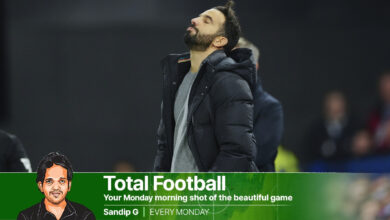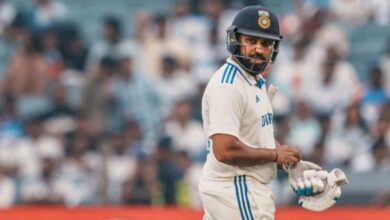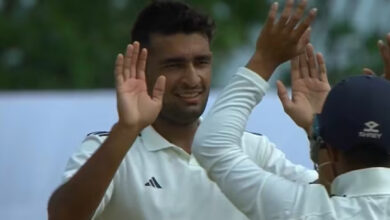Can Pep Guardiola rescue Manchester City from this crisis? | Football News

Only three points from the last four games and six points behind toppers Arsenal on the leaderboard, after arguably the worst performance of the Pep Guardiola era, against Aston Villa, howls of a crisis at Manchester City are intensifying. As horrendous as they were in Villa Park, only a novice would write off last season’s treble-winners at this juncture of the season, four games still for the mid-season break. There is the resounding solace of recent past too, but even the staunchest of City supporters would not feign their club is wading through a semi-crisis. Even their inscrutable manager—u-turning from his conviction that his club is still destined to win the league—admitted that his side is “struggling” and “needs to find solutions” if they are to defend the title for a record third time. It has been a season—stalled no less injuries to key personnel, departure of some of his trusted on-field lieutenants, impeded untimely suspension of key players and the new recruits not yet blending into his style—where what could have gone wrong have gone abominably wrong. It’s a testament to City’s deep bench that they have managed to not utterly falter. But that superior strength on the reserves is the reason there is less sympathy towards City.
Midfield, the central woe
In explaining the deepest woe, Guardiola dwelled on his midfield before the Villa game.“The midfield players are completely opposite to what we have the last seasons.” For all the gifted forwards, the soul of any Guardiola is his midfield. Everything originates from them, the control and vision, the tempo and pace. Everything is designed with them in mind, and it’s the reason he chooses his midfielders carefully, and has harnessed the finest out of some exemplary midfielders.
It’s not creativity that he looks as a prerogative for his midfield, but control and composure. This season City’s midfield has looked more chaotic than probably any other side Guardiola has coached. The absence of Rodri, the midfield supremo due to suspensions in different phases of the campaign has only exacerbated their fallibilities. All three of their defeats in the league this season have come when he was absent at the heart of his midfield.
But how does a team overflowing with talent depend on one-man? It would not have mattered last year, because City still had Ilkay Gündoğan, who could offer the control and calmness, could modulate the game’s flow, recycle possession smartly and kill the game, if need be, with a thousand boring passes. To an extent, so was Riyad Mahrez. In the absence, Guardiola was forced to rejig the midfield, and the iteration at Villa Park was arguably the weakest. The best players suited to man his midfield were deputized on the wings—Bernardo Silva and Phil Foden, which would not have been the case had Doku been fit and Jack Grealish, like Rodri, not suspended. The aftermath was a stitched-up midfield with ragged ends that featured a centre-back returning from an injury (John Stones, adept manning the midfield but not quite starting there), a striker as the eight (Julian Alvarez) and a right-back (Rico Lewis) as the holding midfielder. The plan, to say mildly, went kaput.
It’s where City’s transfer policies too has back-fired, rare as it has been. None of Mateo Kovacic, Matheus Nunes or Kalvin Phillips have made slow progress. In fact, the recent additions have been antithetical to the conventional Guardiola ideals. No one embodies this more than Doku, the jet-toed winger, City’s most potent threat this season, but his directness has threatened City’s midfield equilibrium. How Guardiola finds this balance would be central to City’s comeback hopes.
Defensive fragilities
A hole-ridden midfield taxes the backline. Understandably, despite possessing a stack of high-class defenders, they have shipped in 17 goals, the most they have since 2009-10. Some of them have been unusually error-prone too, like the usually dependable Josko Gvardiol against Arsenal and Nathan Ake. Manuel Akanji is slowly adjusting to the level while Kyle Walker seems to have a few yards of pace. But once the midfield cracks are ironed out, they would be a stingier group.
Manchester City’s Josko Gvardiol in action with Aston Villa’s Leon Bailey Action Images via Reuters
A passing storm?
Is it a full-blown crisis or a passing storm? It is a passing storm that has the potential to transform into a hurricane. But City would be considerably relieved once their regulars return from suspensions and injuries. Stones and Rodri would immediately make them an indomitable group. So would talisman de Bruyne. The latter’s creative prowess renders City another dimension, even if he is not the control-metronome that Guardiola craves for.
But it’s still presumptuous to write City off. Last season, they overturned an eight-point gap and won the league with three games in hand. In 2018-19, they were 10 behind Liverpool, only to snatch the title in the final stretch.
Even with a depleted side, they could still push or glory. And it’s during the second half that Guardiola usually comes up with path-breaking solutions to his problems. The transformation of Stones into a defensive-playmaker is a classic case. Besides, there is quality and experience on the field and bench. Guardiola emphasized that belief: “Over many years together, we were able to find a way to win games, sometimes playing good, sometimes not, but always we found a way to do it. It’s my duty, my job, to find a way to (improve) the situation,” he said.
He is the doctor of the tweak and fix, but this could be the most challenging of all his seasons in England, perhaps the one that would define him. To say this after a treble-winning season, after winning five of the last six league titles in England, only tells of Guardiola’s powers to keep redefining himself.







